Introduction


Ankle fusion is a long established and effective surgical treatment for advanced ankle osteoarthritis. However ankle fusion should only be considered after more conservative treatments have been tried or the condition is considered too advanced for other options.
The ankle needs to flex, allowing the foot to move up and down and to rotate. Because of its size and shape, the ankle receives more stress than any other joint in the body. Consequently, many people develop ankle osteoarthritis, usually due to a previous injury or wear and tear. People with advanced arthritis in the ankle may benefit from fusion.
Who need Ankle Fusion?
Ankle fusion is very successful in terms of leaving the ankle pain free and is very durable. The ankle joint is left stiff, but fusion does not normally result in problems walking, as the other joints remain mobile. Some patients are able to run and play sports like tennis following ankle fusion. Fusion remains the treatment of choice for young and active patients who will put their ankle under considerable stress. Older patients who are less active may consider an ankle replacement as an alternative which preserves a greater degree of mobility in the joint.
How does Ankle Fusion work?
This operation is undertaken to create a permanent joining of the three bones which make up the ankle – the talus, the tibia and the fibula. The damaged cartilage is removed to create a level bone surface.
The next step is to position the bones correctly for the fusion. Metal screws are used to hold the bones in the correct position.
With the correct positioning, the patient will not feel the screws and there is no need for them to be removed in the future.
With the advent of improved arthroscopic (keyhole) equipment, an ankle fusion may now be performed as a minimally-invasive procedure in some patients. This improves wound healing and aids a quicker recovery.
How long will it take to recover?
You are likely to stay in hospital for up to three nights. You will wear a fibreglass cast for 12 weeks. Guided by your physiotherapist, you will begin a limited amount of weight bearing after six weeks, but the emphasis is upon resting and elevating your leg during the first three months.
Physiotherapy plays a critical role in recovery of mobility and strength. At six months, you may have returned to daily activities and by 12 months, resumed the full range of more active pursuits.
Most patients will be able to walk normally, but can experience difficulty running, as the ability to push off with the toes is lost. For this reason, shoes are often fitted with a rocker sole.




